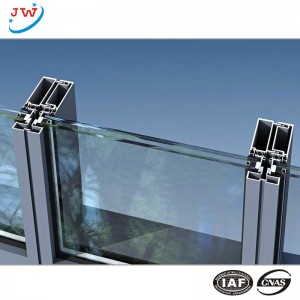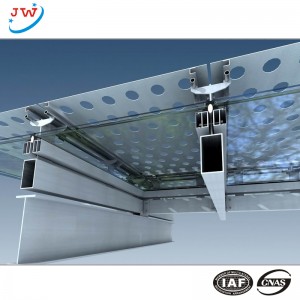Glass curtain wall is divided into fully hidden frame glass curtain wall and semi-hidden frame glass curtain wall. The coated glass of the fully hidden frame glass curtain wall, the upper and lower, the left and right corresponding edges (four periphery), completely rely on the structural glue to stick to the aluminum alloy frame.
Manufacture and installation of hidden frame glass curtain wall
According to the design requirements, hundreds of individual components are pasted according to different specifications, transported to the construction site, suspended and fixed on the aluminum alloy frame composed of vertical bars and transverse bars on the wall, fixed and sealed with glass gaps to form a flat large area continuous wall.
Because the coated glass is used, the aluminum alloy frame pasted behind the glass can not be seen from the outside, only the large area mirror effect formed by the whole wall, the well-done all-hidden frame glass curtain wall, there is no hidden danger, the whole wall will be very flat, upper and lower flatness, verticality error of only a few millimeters, forming a very beautiful large mirror.
The opposite building and the cars are clearly reflected; if the production is not good, or there are hidden dangers, this big mirror will become a mirror, and the cars will be deformed. If only one of the two corresponding edges of the glass is hidden, and the other corresponding edge can be seen, it is the semi-hidden frame glass curtain wall.
Hidden frame glass curtain wall is a relatively new kind of aluminum alloy glass curtain wall in the world. because the curtain wall does not have the traditional aluminum alloy frame used to hold glass and bear load, it completely depends on the structural glue on the back of the glass. the coated glass is glued to the aluminum profile frame, and the coated glass is subjected to horizontal wind load, vertical self-weight cutting, thermal expansion, cold shrinkage due to temperature change and vibration load. The vertical dead weight load, the thermal expansion and cold shrinkage due to the change of temperature and the load under the action of vibration are all transferred to the aluminum alloy frame by the adhesive force of the structural adhesive. Therefore, the coated glass can exist on the aluminum alloy curtain wall without falling off, and the glass can be firmly glued to the aluminum profile frame by the qualified structural glue. Therefore, there are special strict requirements for aluminum, coated glass and structural adhesive.
Normal manufacture and installation of semi-hidden frame glass curtain wall
Semi-hidden frame glass curtain wall can be divided into two types: horizontal and vertical or vertical and horizontal. No matter which kind of semi-hidden frame curtain wall, one corresponding edge is bonded into a glass assembly assembly with structural glue, while the other corresponding edge is assembled by aluminum alloy embedded groove glass assembly method. In other words, when the glass is subjected to various loads, one side is transmitted to the aluminum alloy frame by structural glue, while the other is transmitted to the aluminum alloy frame by the aluminum alloy profile embedded groove. Therefore, the above connection methods of semi-hidden frame glass curtain wall are indispensable, otherwise a corresponding edge will be formed to bear all the load of glass, which will be very dangerous.
The manufacture and installation methods of semi-hidden frame glass curtain wall are briefly described as follows:
1. Vertical concealed glass curtain wall
In this type, only the vertical rod is hidden behind the coated glass, while the crossbar coated glass is embedded in the mosaic groove of the aluminum alloy profile and covered with aluminum alloy laminate. In the actual production and installation, there are two methods (A, B).
A method is as follows: the glass is pasted on the glass frame with installation grooves on the two vertical edges, and the vertical edge of the glass frame is fixed on the vertical rod of the aluminum alloy frame system with a fixed plate, while the upper and lower transverse edges of the glass are fixed in the mosaic groove of the aluminum alloy frame frame beam. The bonding between the vertical edge of the glass frame and the glass frame is completed by glue injection in the special workshop in the factory, the cleanliness of the material surface is guaranteed and the bonding quality is good. The glass frame is shipped to the site for installation after the structural adhesive is completely cured, and the bonding quality is guaranteed.
B production method: the coated glass is first fixed in the mosaic groove of the top and bottom aluminum alloy profiles, and a glue gap slot is formed on the surface of the glass and the vertical rod, and then the structural glue is filled with the gap slot on the spot to form a vertical structural adhesive glass assembly system. This production method is due to on-site glue injection, the material surface is clean and dry, the environmental cleanliness during glue injection is difficult to be fully guaranteed, and the structural adhesive is often subject to wind load before curing, affecting the bonding strength. It is generally limited to buildings with no installation gap between buildings and aluminum alloy frame system, and should not be used unless it is a last resort. When injecting glue on the spot, the glue injection site should be temporarily closed and protected by various methods, and the bonding surface of aluminum and glass should be cleaned. Generally speaking, glue can not be injected on the spot in windy, rainy days and freezing in winter. Recently, we have found that for the sake of simple construction and fast progress, some manufacturers should have injected glue into the reinstallation frame in the factory instead of processing it in the factory, but all injected glue on site. This is very wrong and should be stopped.
2. Horizontal and hidden glass curtain wall
In this system, the structural glass assembly method is adopted horizontally, and the aluminum alloy glass embedded groove is used to fix the vertical. The specific method is that the glass is bonded to the glass frame with installation grooves on the upper and lower sides, the upper frame of the glass frame is supported on the crossbeam of the aluminum alloy frame system, the lower frame is fixed on the lower crossbeam with a fixed sheet, and the vertical edge is fixed on the lower crossbeam with a pressing plate, while the vertical edge is fixed in the glass groove of the vertical rod with a pressing plate, forming a long strip of glass separated by the vertical rod pressing plate from top to bottom. Horizontal and vertical glue can not be injected on the spot, and on-site glue injection is not allowed.
3. Another method of semi-hidden frame curtain wall is to add a pressure plate to the horizontal or vertical edge of the fully hidden frame glass curtain wall to form a semi-hidden frame curtain wall with horizontal or vertical edges. In other words, the fully hidden frame glass curtain wall makes a semi-hidden frame effect. This pressure plate is not only horizontal or vertical decorative lines, but also fixed the glass for the second time, sense of security has been enhanced, but also can change the shape and color of the pressure plate to increase the pattern color.
The above is the difference between hidden frame and semi-hidden frame glass curtain wall. If you want to know more about glass curtain wall, please feel free to contact us.
Learn more about JINGWAN products
Post time: Apr-15-2022


